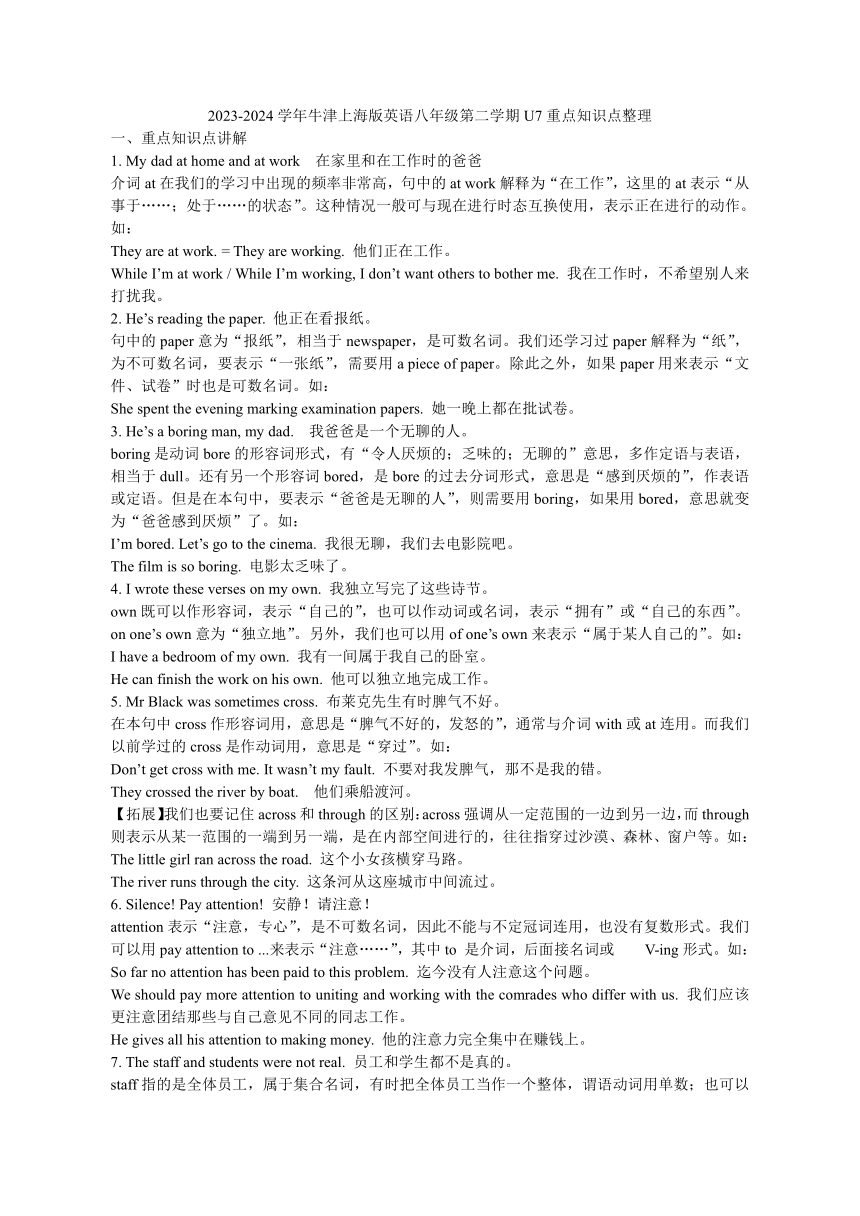
2023-2024学年牛津上海版英语八年级第二学期U7重点知识点整理 一、重点知识点讲解 1. My dad at home and at work 在家里和在工作时的爸爸 介词at在我们的学习中出现的频率非常高,句中的at work解释为“在工作”,这里的at表示“从事于……;处于……的状态”。这种情况一般可与现在进行时态互换使用,表示正在进行的动作。如: They are at work. = They are working. 他们正在工作。 While I’m at work / While I’m working, I don’t want others to bother me. 我在工作时,不希望别人来打扰我。 2. He’s reading the paper. 他正在看报纸。 句中的paper意为“报纸”,相当于newspaper,是可数名词。我们还学习过paper解释为“纸”,为不可数名词,要表示“一张纸”,需要用a piece of paper。除此之外,如果paper用来表示“文件、试卷”时也是可数名词。如: She spent the evening marking examination papers. 她一晚上都在批试卷。 3. He’s a boring man, my dad. 我爸爸是一个无聊的人。 boring是动词bore的形容词形式,有“令人厌烦的;乏味的;无聊的”意思,多作定语与表语,相当于dull。还有另一个形容词bored,是bore的过去分词形式,意思是“感到厌烦的”,作表语或定语。但是在本句中,要表示“爸爸是无聊的人”,则需要用boring,如果用bored,意思就变为“爸爸感到厌烦”了。如: I’m bored. Let’s go to the cinema. 我很无聊,我们去电影院吧。 The film is so boring. 电影太乏味了。 4. I wrote these verses on my own. 我独立写完了这些诗节。 own既可以作形容词,表示“自己的”,也可以作动词或名词,表示“拥有”或“自己的东西”。on one’s own意为“独立地”。另外,我们也可以用of one’s own来表示“属于某人自己的”。如: I have a bedroom of my own. 我有一间属于我自己的卧室。 He can finish the work on his own. 他可以独立地完成工作。 5. Mr Black was sometimes cross. 布莱克先生有时脾气不好。 在本句中cross作形容词用,意思是“脾气不好的,发怒的”,通常与介词with或at连用。而我们以前学过的cross是作动词用,意思是“穿过”。如: Don’t get cross with me. It wasn’t my fault. 不要对我发脾气,那不是我的错。 They crossed the river by boat. 他们乘船渡河。 【拓展】我们也要记住across和through的区别:across强调从一定范围的一边到另一边,而through则表示从某一范围的一端到另一端,是在内部空间进行的,往往指穿过沙漠、森林、窗户等。如: The little girl ran across the road. 这个小女孩横穿马路。 The river runs through the city. 这条河从这座城市中间流过。 6. Silence! Pay attention! 安静!请注意! attention表示“注意,专心”,是不可数名词,因此不能与不定冠词连用,也没有复数形式。我们可以用pay attention to ...来表示“注意……”,其中to 是介词,后面接名词或 V-ing形式。如: So far no attention has been paid to this problem. 迄今没有人注意这个问题。 We should pay more attention to uniting and working with the comrades who differ with us. 我们应该更注意团结那些与自己意见不同的同志工作。 He gives all his attention to making money. 他的注意力完全集中在赚钱上。 7. The staff and students were not real. 员工和学生都不是真的。 staff指的是全体员工,属于集合名词,有时把全体员工当作一个整体,谓语动词用单数;也可以指全体员工们,强调个体,谓语动词用作复数。如: The teaching staff of this college are excellent. 这所大学的教师都是出类拔萃的。 二、练习 I. Choose the best answer: ( ... ...
~~ 您好,已阅读到文档的结尾了 ~~